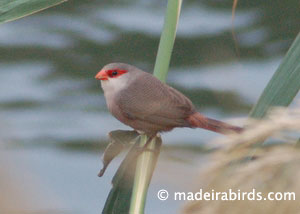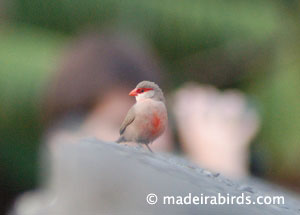Common Waxbill Estrilda astrild (Linnaeus, 1758)
Order: Passeriformes Family: Estrildidae Status: Breeding in Madeira



Common Waxbill Field ID Keys
Shape & Size
Medium-sized passerine with conical bill and roundish wings.
Colour Pattern
It has a grey-brown body with fine dark barring upper-parts while underparts are lightly barred with a pinkish-red belly patch and dark ventral region and tail. It is easily identified by its bright waxy-red bill and eye-mask on adults. Younger birds have dark brown bill and paler body. Females and males are not easily distinguished as their colours and size are very similar in the winter but in summer males show much more red on the ventral area.
Behavior
This species is sociable and generally quite tame, being seen in big flocks with a constant reedy twittering, both when flying or sitting.
Habitat
Common Waxbill is an African species introduced to Madeira where it now breeds locally in places with tall grass as marshes or reed beds, usually near fresh water and are observed from sea-shore level up to 400 meters of altitude. It also occurs in Porto Santo island.
Distinction from similar species
If seen well it is unlikely to be confused with any other European species.
Estrilda astrild Biometrics
Total length: 11 cm (Ertel, 2009)
Weight: 9 g (Cardona & Esteban, 2002)
Other Bird Facts
Seasonality in Madeira: All year
Breeding: Built deep in dense vegetation with grass stems interlaced on a large ball shape, Waxbills’ nests hold between 4 to 5 eggs on each of the up to 4 annually broods.
Diet: Feed on seeds and some insects
Status
Madeira local status by Correia-Fagundes et al, 2021: Common breeding bird
Madeira local status by Romano et al, 2010: Rare breeding bird
Conservation status by the IUCN Red List Categories, 2013: Least Concern ver 3.1
Name of this species in other languages
Portuguese: Bico-de-lacre
German: Wellenastrild
Dutch: Sint-Helenafazantje
Swedish: Helenaastrild
Danish: Helenaastrild
Finish: Vahanokka
Norwegian: Vatreastrild
Spanish: Pico de Coral
French: Astrild ondulé
Italian: Astrilde comune
Polish: Astryld falisty
Slovak: Astrilda vlnkovaná
Czech: Astrild vlnkovaný